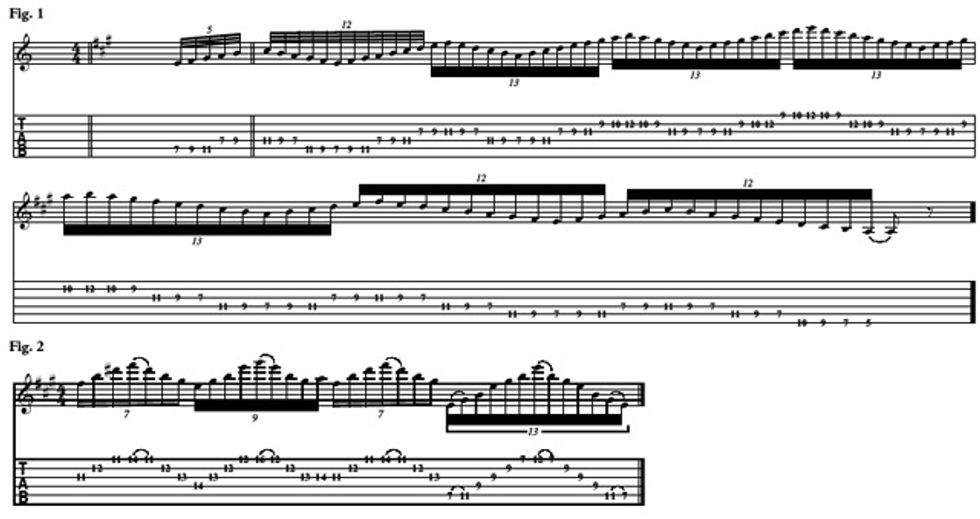Throughout the years, I’ve been asked
many questions, the most popular being:
How did I develop my technique? More
specifically, what is the best way to increase
picking speed when you seem to have hit the
velocity ceiling?
We’ve all been there. You know the feeling.
You set the metronome to a given speed and
play accurately to the beat. As you increase the
tempo, you eventually max out at the same
point, over and over again. There seems to
be a disconnection between different speeds.
There’s slow, medium, fast and turbo! (And as
you know, all of us aim for turbo, whether or
not we want to admit it.)
I contend that reaching that top speed
sometimes has more to do with a certain feel
than it does just adhering to a strict beat. I
think it physically feels different and we honor
a whole different set of approaches than at a
slower tempo. More so, it’s how we hear or
view the notes we’re playing. Let me explain.
When we’re diligently slaving away, playing
to a fast beat, we’re usually picking to a
standard subdivision of the beat (quarter-note,
eighth-note, sixteenth-note, and so on). It’s
most likely we view each note singularly and
play its subdivisions with an even, unaccented
consistency. This approach is valid and has
served us well up until this point. Yet now, it’s
this point we want to get past.
I’ve noticed that if I group the notes differently
in my mind while accenting certain
ones I get different results. If I think of a
grouping or a phrase of notes instead of just
the single notes, I experience a much different
feel, and therefore, a different result on
the guitar. The key to this is that I accent a
certain note in each phrase, and that note
becomes my focus point.
As I’m playing this grouping of notes, I
make sure that my “focus note” lands on a
certain beat. As long as I make sure this note
lands consistently on a particular beat, all the
other notes in the phrase move accordingly
around it. By placing the accent on a certain
beat, we automatically delineate the phrase.
This gives us our grouping feel.
Fig. 1 shows a scale broken down to groupings.
I find that more often than not, the
accented note is not the first note in the phrase,
but rather the phrase’s highest or last note.
The accented note is the key to making this
approach work. I aim for it and by doing so, all
the other notes in the phrase fall into place. Download example audio...
This approach also translates to other guitar
techniques. Take sweep picking, for example.
I’ve always viewed sweep picking as a “timeless”
technique—not in any historical sense, but in
the sense that you can fit a sweep (regardless
of how many notes it contains) into a required
space by viewing it in groups or phrases.
Now take a look at Fig. 2, where I play
some arpeggios with unusual groupings. To
accomplish this, I have to treat each arpeggio
as one grouping or phrase and make sure that
the first note of the group falls on the quarter
note (in this example). Don’t be intimidated
by the value or numerical grouping of the
notes. Remember, this phrase is only as fast as
the tempo you choose, so it looks scarier than
it really is. The audio example that illustrates
this concept is a song called “Magnus 212”
from my upcoming CD, 212. You’ll hear
some other grouping examples in this audio
clip as well. Download example audio...

The advantage of this approach is that it feels different to play these riffs if the notes are grouped and the phrases have an accent in them. I believe that viewing fast lines this way opens up your technique, because it feels different to play with accents and groups instead of playing straight up with the metronome. Where you would think of one note, now you can visualize a phrase around it.
Neil Zaza
Neil Zaza tours the world constantly, playing his own brand of melodic instrumental guitar. He is currently recording his latest album, 212, and you can visit him at neilzaza.com as well as facebook.com/neilzazamusic.









![Rig Rundown: Russian Circles’ Mike Sullivan [2025]](https://www.premierguitar.com/media-library/youtube.jpg?id=62303631&width=1245&height=700&quality=70&coordinates=0%2C0%2C0%2C0)







